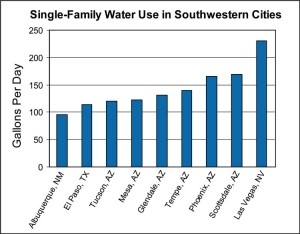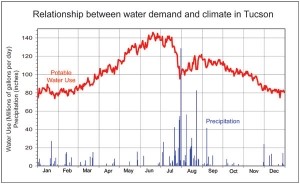Groundwater in the Arid Southwest
Groundwater plays a critical role in human development and in maintaining important natural ecosystems in the arid Southwest. It helps sustain the flow of streams and rivers and maintains riparian and wetland habitats that are vital to plants, animals, and people. Groundwater also provides drinking water to urban and rural communities and supports agriculture and industry, all of which have helped enable rapid population growth in Arizona and New Mexico. Population expansion, however, has not been without its consequences. It has led to increasing groundwater withdrawals that are outpacing the rate at which the vital resource is naturally replenished. As a result, the region’s groundwater resources are among the most overused in the United States.

Figure 1. Historic aquifer water-level declines in the Southwest.
| Enlarge This Figure |
Credit: S. A. Leake1, United States Geological Survey
In less than a century, the volume of water in underground reservoirs that accumulated over thousands of years has been reduced by urban development and agriculture. These reductions in water storage now require active management to prevent the depletion of these aquifers.
The challenge to water managers and users is grand and urgent: balance water consumption with sustainable supplies in a region where future demand will likely increase, and future supply will likely decrease. Sustainable water use requires integrating knowledge of numerous factors, including the Southwest’s limited water supplies, pressures imposed by an increasing population, and high-impact changes in the hydrologic cycle driven by climate change. Proper management by private and public interests will require understanding:
- Groundwater use in the Southwest
- Climate and the groundwater balance
- Impacts of climate and society changes on groundwater resources
Groundwater use in the Southwest
Changes in groundwater supplies are influenced predominantly by climate and human consumption. In the absence of human use, the volume of groundwater generally expands as water from streams, rivers, and precipitation seep into the ground in quantities that exceed what is withdrawn by vegetation or lost to evaporation. With the expansion of human development, however, groundwater has been increasingly withdrawn from wells to support agricultural, industrial, and municipal demand at rates that have outpaced natural recharge. As a result, the depth of the water level below ground has declined in many aquifers, in some areas by more than 200 feet (or 60 meters; see Figure 1).

Figure 2. Single-family water use in southwestern cities.
| Enlarge This Figure |
Credit: Zack Guido, CLIMAS, The University of Arizona
Groundwater alone cannot satisfy the region’s water demand. Water in rivers, such as the Colorado and Rio Grande, is considered sustainable and is diverted to help meet demand and reduce the overuse of groundwater. The Central Arizona Project (CAP) diverts Colorado River water to areas in Arizona. In 2003, CAP channeled 3.7 billion gallons of water to users (1.15 million acre-feet). That amount, however, only supplied about 15 percent of Arizona’s 2.5 trillion gallons used in 2003, a conservative estimate that would fill approximately 7.8 million acres with water one-foot deep. CAP water and water from other rivers such as the Salt and Verde accounted for approximately 55 percent of the total water used in 2003, while groundwater provided about 45 percent.
Both groundwater and surface water supply residents with water. In the larger cities in the Southwest, the volume used by single family homes ranges from less than 100 gallons per day to nearly 250 gallons (Figure 2). Agriculture, and not residential water use, is the biggest drain on groundwater. In 2000, about 80 percent of total groundwater withdrawn in Arizona and parts of other western states, including New Mexico, was for irrigation.
Climate and the groundwater balance

Figure 3. Relationship between water demand and climate in Tucson, Arizona. Mostly notable is how demand drops as the summer monsoon begins. Maximum daily potable water demand (red) in Tucson Water utility’s service area (based on 2005-2007 data), and average daily precipitation at Tucson International Airport (blue).
| Enlarge This Figure |
Credit: Zack Guido, CLIMAS, The University of Arizona
Groundwater supplies fluctuate when inflows into the systems do not balance outflows. The inflows into aquifers are driven by rain, snow, and streamflow, while the outflows are dominated by evapotranspiration—the process by which vegetation uses water in the soil for plant growth—evaporation, and well pumping.
Climate and water use are intimately connected. When precipitation declines, the inflows typically drop, while pumping may increase. When temperature increases, evaporation generally increases—reducing streamflow and the amount of water in reservoirs—while people generally pump more water. In Tucson, for example, potable water use is lowest during mid-winter but increases when temperatures begin to rise and winter precipitation wanes (Figure 3). Water use peaks before the major thrust of summer thunderstorms and then nose-dives during the height of the monsoon season.
In the Southwest, although about half of the region’s precipitation falls in the summer, it is the winter rains that are primarily responsible for replenishing groundwater. The long-lasting winter storms enhance infiltration, while the cooler temperatures reduce evaporation and the plants demand less water.
Impacts of climate and society changes on groundwater resources
Future scenarios for the Southwest paint a region with warmer temperatures, a larger population, and perhaps less rain. Global climate models (GCMs) project the West will warm between 3.5 and 9 degrees F (2 to 5 degrees C) by the end of this century, while an additional 4.8 million people will inhabit Arizona and New Mexico by 2030. And although GCMs do not present a clear image of future precipitation, some models suggest a 10 to 15 percent decrease. The confluence of these changes will impact snowpack, evaporation, energy consumption, pumping, and winter storms, all of which impact groundwater supplies.
Air temperatures in the Southwest have increased in the past century and have been linked to reductions in snowpack. Future climate change will likely continue to diminish snowpack at higher elevations and therefore reduce groundwater recharge. Temperature increases will also hasten the evaporation of soil moisture after rain and snow storms, reducing the amount of water that seeps into aquifers.
Warmer temperatures may also bump up water consumption in the winter, and therefore groundwater withdrawals, as higher temperatures often correlate with increased water use. Higher summer temperatures also increase energy consumption as people run air conditioners to keep homes and buildings at comfortable temperatures. Because about 8.0 gallons of water are needed to generate one kilowatt of energy in Arizona, greater energy consumption demands more water, a fraction of which will be from groundwater.
Scenarios that depict decreases in winter precipitation are significant because winter precipitation is considered to be more important in replenishing groundwater than summer rain. Declines in winter precipitation have already been observed and linked to human-caused climate change. Research in 2008 concluded the winter storm tracks in the western U.S. shifted north between 1978 and 1998, delivering fewer rain and snow events to Arizona and western New Mexico, among other western states.
In addition to winter precipitation, summer monsoonal rains provide a portion of the total groundwater recharge. Although it is not well-known how climate change will alter future monsoon seasons, current water consumption in Tucson declines when the monsoon rains ramp-up. This suggests that if the monsoon season becomes shorter and less intense, future water consumption may increase. The converse is also true but would have a positive effect on groundwater supplies.
Regardless of climate change, population growth will affect water consumption. Expected growth will increase water demand, which will be partially satisfied by groundwater. It will also raise energy consumption, causing a simultaneous increase in water use.
References
- Leake, S.A., A.D. Konieczki, and J.A.H. Rees. 2000. Desert basins of the Southwest. U.S. Geological Survey Fact Sheet 086-00, 4 p.
- Arizona Department of Water Resources. 2006. Arizona Water Atlas: Introduction. Vol 1. AZ Water Atlas (Last accessed October 2008).
- Stonestrom, D.A. and J.R. Harrill. 2007. Ground-water recharge in the arid and semiarid southwestern United States-climatic and geologic framework. U.S. Geological Survey Professional Paper 1703-A, 27 p.
- Cubasch, U., et al. 2001. Projections of future climate change. In Climate change 2001: The Scientific Basis. Contribution of Working Group I to the Third Assessment Report of the Intergovernmental Panel on Climate Change, [Houghton, J.T.,Y. Ding, D.J. Griggs, M. Noguer, P.J. van der Linden, X. Dai, K. Maskell, and C.A. Johnson (eds.)]. pp. 525-582. Cambridge University Press, Cambridge,UK and New York City, NY, USA.
- IPCC. 2007. Climate Change 2007: The Physical Science Basis. Contribution of Working Group I to the Fourth Assessment Report of the Intergovernmental Panel on Climate Change. [Solomon, S., D. Qin, M. Manning, Z. Chen, M. Marquis, K.B. Averyt, M. Tignor and H.L. Miller (eds.)]. Cambridge, UK and New York City, NY, USA: Cambridge University Press.
- Torcellini, P., N. Long, and R. Judkoff. 2003. Consumptive water use for U.S. power production. Technical Report NREL/TP-550-33905. Golden C: National Renewable Energy Laboratory.
- McAfee, S.A. and J.L. Russel. 2008. Northern Annular Mode impact on spring climate in the western United States. Geophysical Research Letters, 35, L17701, doi: 10.1029/2008GL034828.

